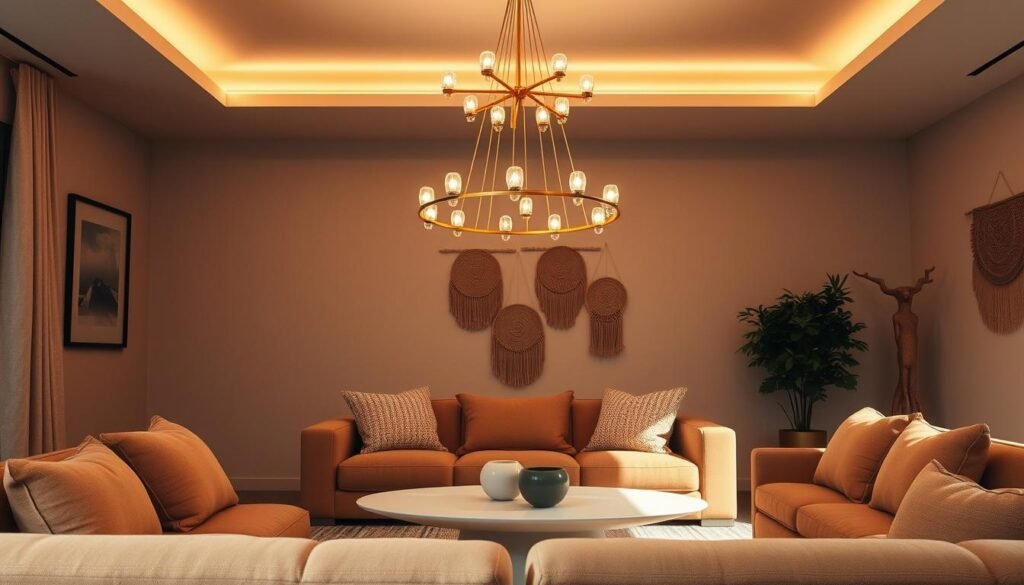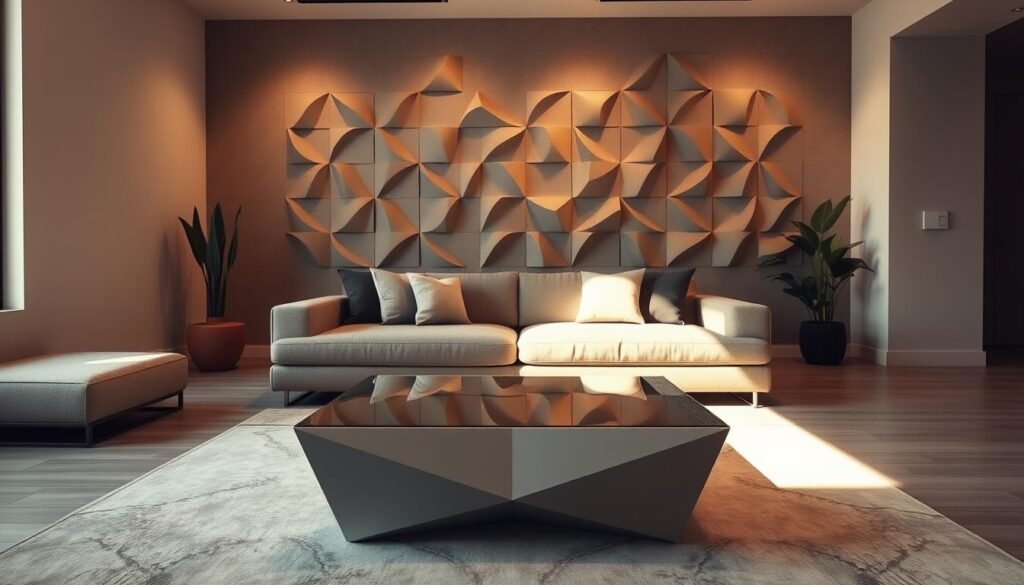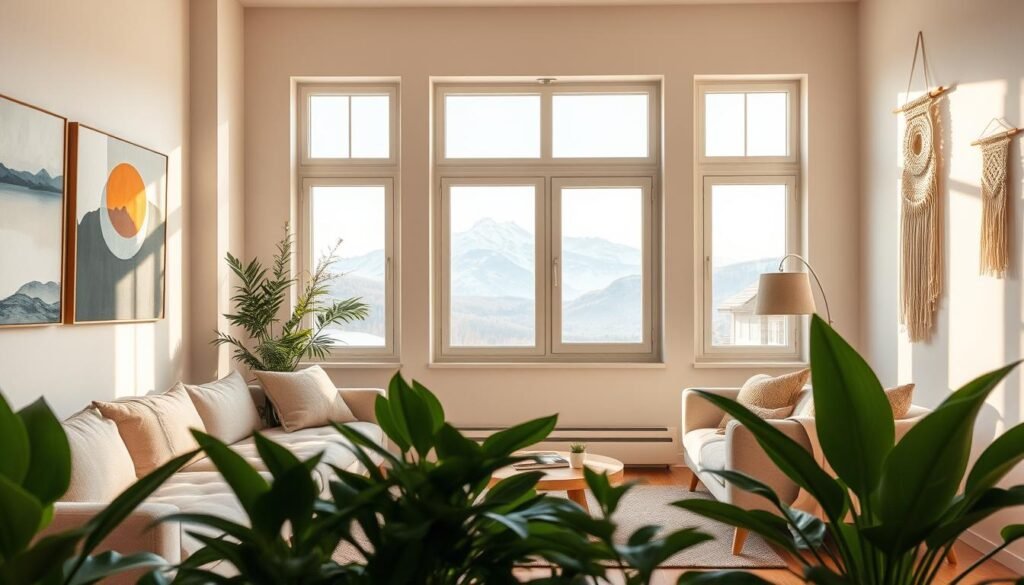This post may contain affiliate links. When you purchase through links on our site, we may earn an affiliate commission.
Can our living spaces really affect our mental health? Mike Peterson, Founder of The Official Science in Design Certification Program, thinks so. He says neuroaesthetics is a new field that links neuroscience and aesthetics. It’s about how our brains react to beauty and design1.
This idea of designing spaces for our brains has caught my attention. I’m eager to share 7 neuroaesthetic design ideas. These ideas can make your home a better place for your brain, using residential neuroaesthetics principles.
Neuroaesthetic design is about making spaces that are not just pretty but also good for our minds. By using these principles, we can boost our mental health and mood. This is a key part of neuroaesthetic and cognitive interior design2.
As I dive into neuroaesthetics, I see it’s more than just looks. It’s about making spaces that make us feel good and happy. This is at the heart of residential neuroaesthetics3.
Key Takeaways
- Neuroaesthetic interior design can improve mental well-being and mood through the application of cognitive interior design principles.
- Residential neuroaesthetics involves creating spaces that promote well-being and happiness.
- Cognitive interior design considers the impact of design on the brain and behavior.
- Neuroaesthetic design ideas can be applied to create brain-friendly interiors.
- Understanding the principles of neuroaesthetics can help you make informed design decisions for your space, incorporating elements of neuroaesthetic interior design and residential neuroaesthetics.
What is Neuroaesthetic Interior Design?
Exploring interior design, I find neuroaesthetic design fascinating. It blends neuroscience in decor with brain-friendly interiors. This mix aims to make spaces that boost our mental health. Studies show that natural light and calming colors can lower stress and anxiety4.
Neuroaesthetic design uses innovative design psychology. It’s about making spaces that are not just pretty but also peaceful. Adding greenery and natural textures can reduce stress and improve thinking4. These elements help create interiors that are good for our brains and mood.
Looking into neuroaesthetic design, we see its impact on our mental state. Clutter can make us feel stressed, showing the need for clean spaces4. By using neuroaesthetic design, we can make spaces that are not just nice to look at but also good for our minds.
Essential Principles of Neuroaesthetics
Creating a mindful home environment involves several key principles. Harmony and balance are crucial, achieved through sensory stimuli in design. This includes color, textures, and materials. Research shows that spaces with moderate visual complexity are more pleasing, leading to comfort and positive emotions5.
Emotional design techniques are also vital in neuroaesthetic design. Color psychology plays a big role here. Warm colors like red and yellow boost creativity and energy. Cool colors like blue and green promote relaxation6.
Key elements for a mindful home include:
- Using natural materials and textures for warmth and comfort
- Incorporating plants and greenery for calm and well-being
- Utilizing emotional design techniques like color psychology for mood and atmosphere
https://www.youtube.com/watch?v=1oNK6y18zqQ
How to Choose the Right Color Palette
Choosing the right color palette is key to creating a harmonious space. Colors can greatly affect our mood and emotions7. Understanding the psychology of space design helps us create interiors that are good for our brains.
Warm colors like oranges and yellows bring energy, while cool colors like blues and greens calm us8. The right color combinations can make a space feel personal and relaxing. This way, your space can reflect your personality and style.
When picking colors, think about the room’s natural light and the colors of furniture and decor7. Consider the mood you want in the space. For example, a bedroom might need soft blues or warm neutrals, while a home office might do better with bright yellows or oranges. By choosing colors carefully, you can make a space that looks great and feels good for your brain.
Experimenting and having fun is the best way to find the right color palette. Try different colors and combinations to see what works for you. With patience and creativity, you can make a space that’s good for your well-being and happiness. It will show off the principles of cognitive interior design and the psychology of space design8.
The Role of Light in Neuroaesthetic Design
Exploring neuroaesthetic interior design, we see how light affects our mood. It’s key to mix natural and artificial light for a calm and productive space. Studies show that the right lighting can boost our mood and work efficiency9.
Design psychology tells us that light can change how we feel. Warm lights make us feel calm, while soft shapes release oxytocin, making us feel safe9. In neuroaesthetic design, light is crucial for creating a cozy and welcoming space.
Here are some tips for using light in design:
- Use natural light to lift our mood and energy
- Balance warm and cool tones for a harmonious feel
- Try different lights to add interest to the space

By following these tips, we can make spaces that are not just pretty but also good for our emotional health. As we dive deeper into neuroaesthetic design, remember how light shapes our feelings and experiences10.
Incorporating Nature into Your Space
Creating a mindful home environment is key for our well-being. One way to do this is by adding nature to our spaces. Emotional design, like biophilic design, helps us feel connected to nature and boosts our mood11. shows biophilic design is becoming more popular in interior design. It brings natural elements indoors to help us feel closer to nature.
Using natural textures and colors in design can also make our space feel calming. For instance12, found that blues and greens can improve focus and calmness by up to 20%13. also notes that natural materials like wood and stone can lower stress levels in our homes.
Here are some ways to bring nature into your home:
- Adding indoor plants to improve air quality and reduce stress
- Using natural materials, such as wood and stone, in your design
- Incorporating elements of nature, like a water feature or a living wall
By adding these elements, you can make your home a peaceful and calming space. This is achieved through emotional design techniques and sensory stimuli in design121113.
Patterns and Shapes: Aesthetic Considerations
Patterns and shapes are key in cognitive interior design. They affect our emotions and mood. Research shows that certain designs, like symmetry, are hardwired into our brains14.
Using natural elements and warm colors can make us feel good. This is because they release dopamine in our brains15. This idea is linked to biophilic design, which aims to connect us with nature.
By using designs that mimic nature, we can feel calm and well. For example, curvy designs have been popular for four years. They are linked to a growing trend of femininity and motherhood15.
Here are some tips for using patterns and shapes in design:
- Use symmetry and balance for calm and stability
- Add natural patterns and shapes for a connection to nature
- Choose colors that make us feel good, like warm colors for alertness or cool colors for calm14

Understanding the psychology of space design helps us create positive spaces. As research grows, we’ll see more science in design15. Using patterns and shapes, we can make spaces that are not just beautiful but also welcoming.
Planning Functional Spaces with Neuroaesthetic Principles
Neuroaesthetic interior design is key in making spaces functional. It combines residential neuroaesthetics and innovative design psychology. This way, we create spaces that are not just pretty but also good for our health and work.
Studies show that natural light boosts focus and performance in schools16. Also, cooler light makes us more alert, perfect for work and reading16.
A good space should let people move easily. We can make areas for different things like work, rest, and socializing. For example, a living room can be for quiet reading and big parties.
Using touchable materials and curved shapes makes spaces more fun. It changes how we feel and act in them17.
Some important things to think about when planning spaces include:
- Changing spaces for new uses, like turning old areas into new ones17
- Designing for movement, with things like green walls and courtyards17
- Adding plants and natural stuff to feel better and heal16
By using these ideas, we make spaces that help us live better. Whether it’s our home, office, or public areas, neuroaesthetic interior design and residential neuroaesthetics make our lives better. They make our environments beautiful and useful, improving our lives17.
Creating Visual Interest with Art and Decor
Creating a mindful home involves using emotional design techniques. Adding artwork and decor can make a space look great and feel welcoming. Studies show that looking at art can release dopamine, making us feel loved18.
Choosing the right artwork and displaying it thoughtfully is key. Mixing frame styles and sizes can add depth to a room. Adding natural elements, like plants, can also bring calmness19.

Don’t forget to add personal touches that show your style. This could be a favorite piece of art or a sentimental object. These elements make a space feel truly yours, offering comfort and relaxation.
Tips for Implementing Neuroaesthetic Design at Home
Starting small is key when you want to bring neuroaesthetic design into your home20. Begin with small changes and try out new accessories. This way, you can make your space feel more welcoming and inviting. It’s a smart move for your mental health and happiness.
A well-designed space can really affect how you feel and act. That’s why brain-friendly interiors are getting more popular. By adding elements of psychology of space design, you can make a space that helps you relax, be productive, and feel happy. For instance, using natural materials like wood and stone can make your space feel calm and cozy20.
- Start with small changes, such as rearranging furniture or adding plants
- Experiment with different accessories, such as lighting or textiles
- Evaluate and adjust your design choices based on how they make you feel
By using these tips and adding neuroaesthetic design elements, you can make a space that’s good for your mind and heart21.
Conclusion: Your Journey in Neuroaesthetic Design
Reflecting on your journey in22neuroaesthetic design, I hope you feel proud and accomplished. You’ve learned to create a space that’s not just pretty but also good for your mind23. Keep making changes and updates to your space as you grow and change.
Think of your home as a canvas for expressing yourself. It’s a place that shows off your personality and story.
I urge you to share your journey with others23. Their feedback and ideas can help you improve and find new ways to design. Stay curious, keep learning, and listen to your gut as you explore the world of22residential neuroaesthetics.
FAQ
What is neuroaesthetic interior design?
What are the essential principles of neuroaesthetic design?
How do I choose the right color palette for my space?
What is the role of lighting in neuroaesthetic design?
How can I incorporate nature into my space?
How do patterns and shapes affect the neuroaesthetic design of a space?
How do I plan functional spaces with neuroaesthetic principles?
How can I create visual interest with art and decor in a neuroaesthetic way?
How do I start implementing neuroaesthetic design at home?
Source Links
- Neuroscience Informs Design, Now What? Towards an Awe-inspiring Spatial Design | The Centre for Conscious Design – https://theccd.org/article/neuroscience-informs-design-now-what-towards-an-awe-inspiring-spatial-design/
- Is Designing for Neurodiversity a Part of Your Practice Yet? Here’s Why It Should Be – https://www.architecturaldigest.com/story/is-designing-for-neurodiversity-a-part-of-your-practice
- Neuroaesthetics at Play – https://www.muuto.com/about-design-contest/neuroaesthetics-at-play/
- Neuroaesthetics: Designing Mindful Spaces for Mental Well-being – https://www.homeguide.com.sg/neuroaesthetics-designing-mindful-spaces-for-mental-well-being/
- an introduction to neuroaesthetics in wellness interior design — wellness design consultants – https://biofilico.com/news/neuro-aesthetics-in-wellness-interior-design-healthy-buildings
- GAIL RACE INTERIOR DESIGN | The Importance of Neuroaesthetics in Interior Design – https://gailrace.com/journal/2024/11/6/the-importance-of-neuroaesthetics-in-interior-design
- What Is Neuroaesthetics in Interior Design? — McLain by Design Interiors – https://www.mxdinteriors.com/blogcollection/what-is-neuroaesthetics-in-interior-design
- A Neuroaesthetics Approach to Home Design with Lisa Peck | Artful Living Magazine – https://artfulliving.com/lisa-peck-lilu-interiors-neuroaesthetics-home-design-interview/
- Unlocking the Power of Neuroaesthetic Design with Novel Grey – https://www.thenovelgrey.com/stories/unlocking-the-power-of-neuroaesthetic-design-with-novel-grey?srsltid=AfmBOoq6T4J5X10Cjx0mRUDUMTUhlPP_KyUvD8YFd1xAiNrXtHMF7ZG6
- Enhancing Well-being: The Power of Neuroaesthetics in Commercial Interior Design – https://www.totalfitouts.com.au/blog/enhancing-well-being-the-power-of-neuroaesthetics-in-commercial-interior-design/
- How Neuroaesthetics Enhances Your Home’s Interior Design – Studio Mae Interiors – https://studiomaeinteriors.com/how-neuroaesthetics-enhances-your-homes-interior-design/
- GOTW 2 – https://www.gardenonthewall.com/blog/how-to-incorporate-neuroaesthetics-neuroarchitecture-principles-into-your-living-or-workspace
- Unlocking the Power of Neuroaesthetic Design with Novel Grey – https://www.thenovelgrey.com/stories/unlocking-the-power-of-neuroaesthetic-design-with-novel-grey?srsltid=AfmBOorhoFI0DbKnYxJMBoOCbb5nPdunDQtWFCeMCBESdupHeHdhGj5O
- Designing with the brain in mind: a deep dive into neuroaesthetics – https://uxdesign.cc/designing-with-the-brain-in-mind-a-deep-dive-into-neuroaesthetics-c4c898dd789c
- Brain Waves: The Neuroscience Behind Interior Design | Home Accents Today – https://www.homeaccentstoday.com/furniture-lighting-and-decor/brain-waves-neuroscience-behind-interior-design/
- Designing Intentional Spaces for well-being – https://professionals.muuto.com/content/stories/theme-stories/designing-intentional-spaces-for-well-being/
- Neuroaesthetics: Mental Health Facilities of the Future – https://proto.life/2021/10/neuroaesthetics-mental-health-facilities-of-the-future/
- The Psychology of Interior Design; How design choices can affect our well-being~ – Stephanie Nickolson Design, Inc. – https://snickolsondesign.com/2020/08/17/psychology-and-interiors-how-design-choices-can-affect-our-well-being/
- The inextricable link between decoration and mental wellbeing – https://www.houseandgarden.co.uk/article/interiors-and-wellbeing
- Neuroaesthetics: The science behind Interior Design — KHAIA – https://www.khaia.co.uk/stories/neuroaesthetics-interior-design
- Neuroaesthetics & Design – How To Re-jig Our Brains – https://www.lovethatdesign.com/article/neuroaesthetics-design-how-to-re-jig-our-brains/
- Neuroaesthetics in Interior Design: Part 3 — Urbanology Designs – https://www.urbanologydesigns.com/blog/neuroaesthetics-part-3
- GOTW 2 – https://www.gardenonthewall.com/blog/exploring-the-impact-of-neuroaesthetics-biomimicry-on-workplace-well-being

 using WordPress and
using WordPress and 
No responses yet